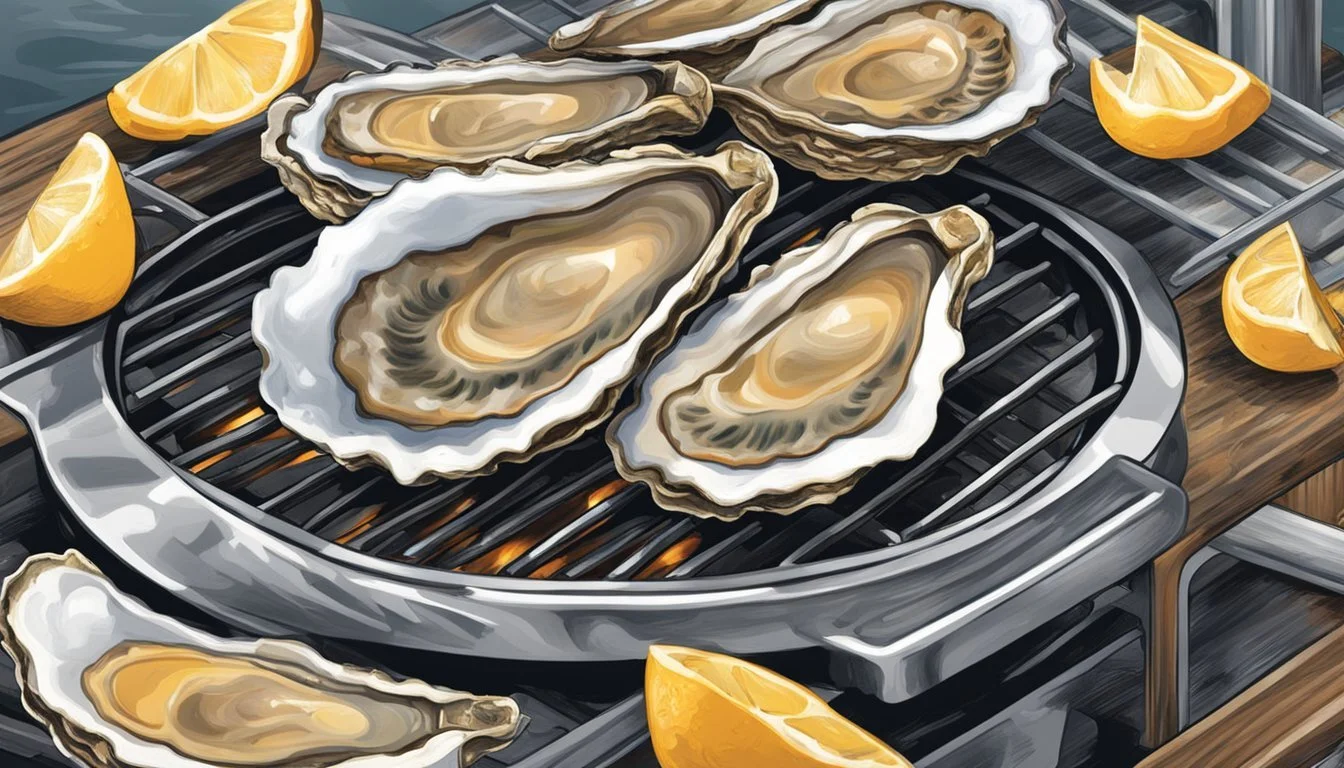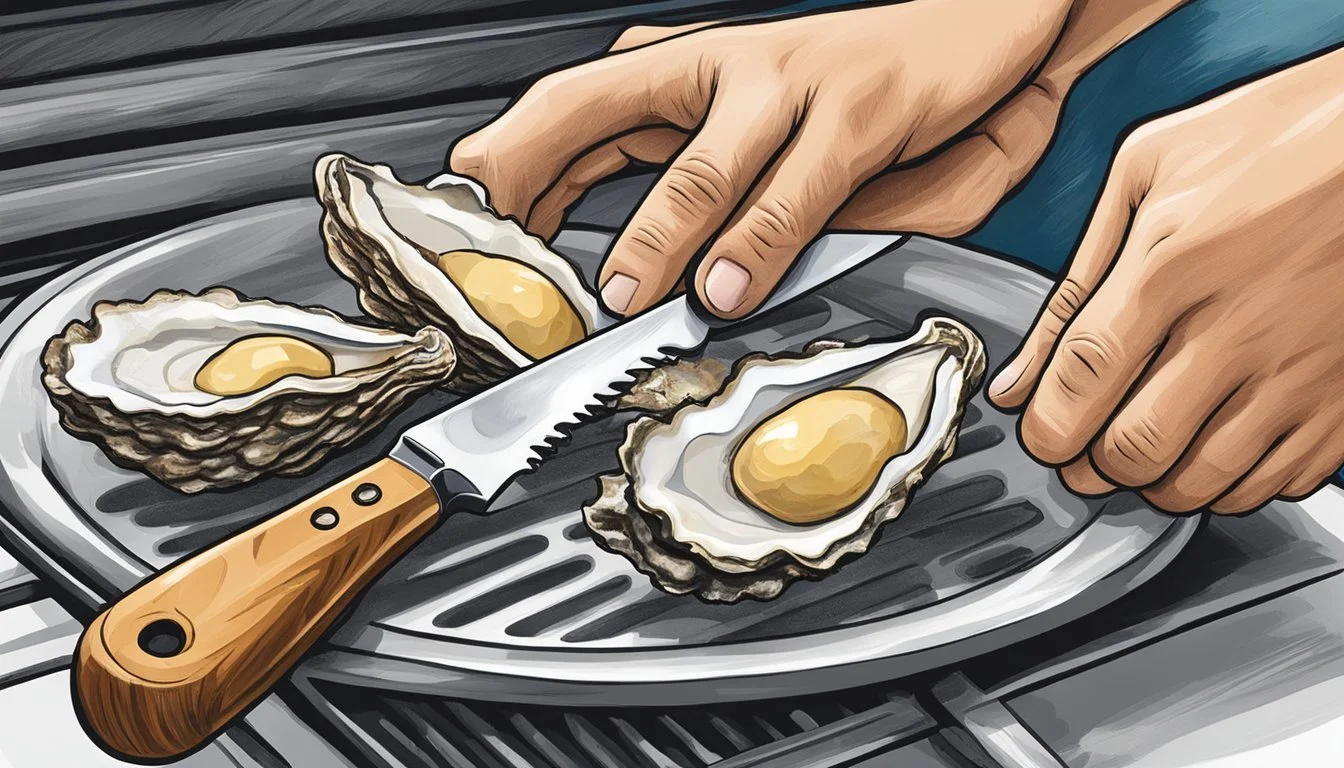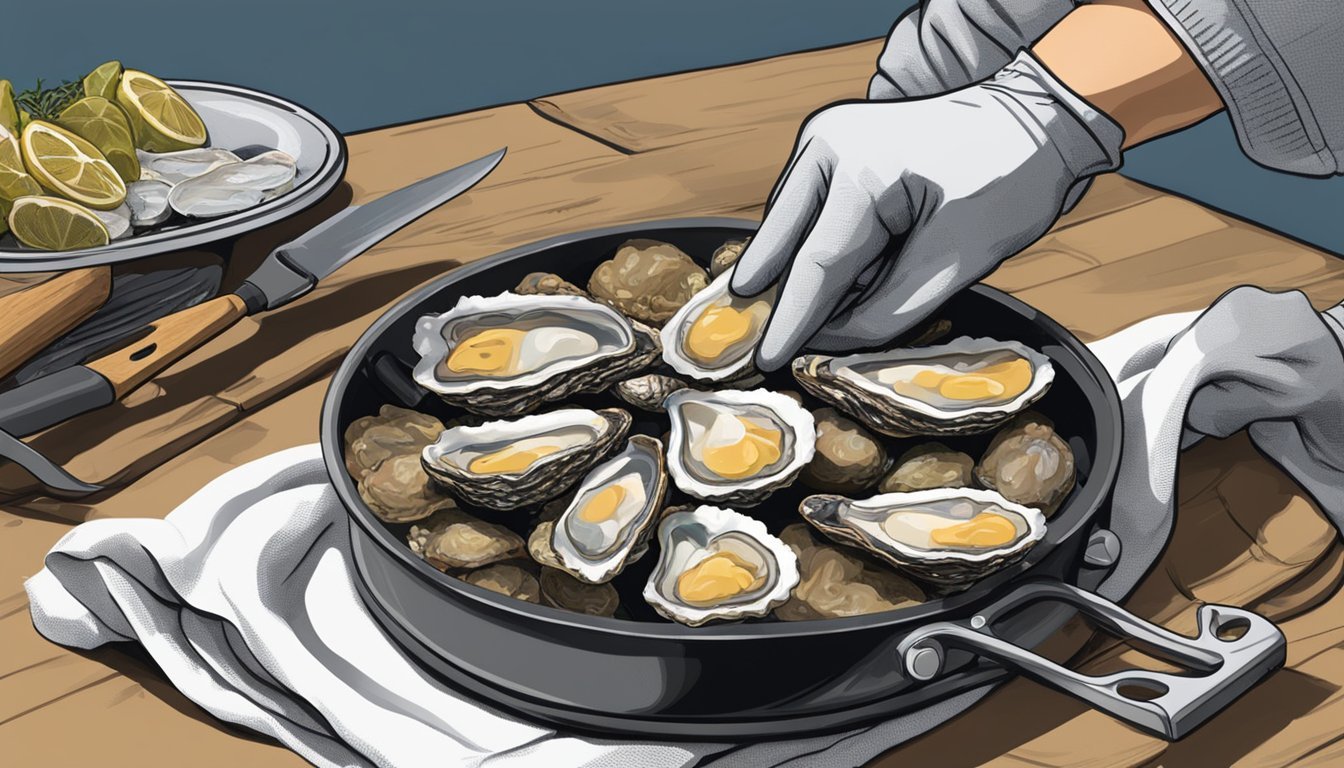How to Shuck and Grill Texas Gulf Oysters
A Step-by-Step Guide
Shucking and grilling oysters is a culinary tradition deeply rooted in the coastal regions bordering the Gulf of Mexico. As both a delicacy and a pastime, this practice holds a cherished spot in the hearts of seafood enthusiasts. The unique flavor and texture of Gulf oysters (What wine goes well with oysters?) make them particularly sought after, offering a taste that is as much a tribute to their marine environment as it is a treat for the palate.
Preparing Texas Gulf oysters begins with shucking, an art that requires precision and care. Shucking involves carefully opening the oyster's hard shell to reveal the plump meat inside, all the while preserving the oyster's natural liquor — a flavorful brine that is a signature of fresh oysters. It's a skill that, once mastered, significantly enhances the experience of enjoying this exquisite seafood.
Grilling oysters introduces a smoky nuance that complements their natural salinity and sweetness. Achieved by placing the shucked oysters on a hot grill and cooking them just until their edges start to curl, this method highlights the oyster's texture and deepens its flavor profile. Whether seasoned simply with salt and pepper or enhanced with a buttery sauce, grilled Texas Gulf oysters offer a simple yet sophisticated dish that appeals to novices and connoisseurs alike.
Understanding Oysters
Oysters are a culinary delight from the ocean, especially treasured in the Gulf region, and understanding their types, anatomy, and sourcing is essential for any seafood enthusiast.
Types of Oysters
There are several types of oysters, with distinct flavors and textures based on their habitat. The Gulf Oyster from the Gulf of Mexico is known for its sweet and mild taste. Oyster types commonly found in the United States include the Pacific Oyster, cultivated mostly on the West Coast, and the Kushi Oyster, a smaller variety with a clean and crisp flavor. Each oyster type has a unique flavor profile influenced by its environment, a phenomenon known as "merroir."
Oyster Anatomy
An oyster's anatomy is key to its function and taste. The main parts include:
Shell: A hard, protective layer composed of two valves.
Mantle: The organ that secretes the shell.
Gills and Palps: Work together for feeding and respiration.
Adductor Muscle: The muscle that closes the shell and must be severed to shuck the oyster.
Understanding the anatomy is crucial when shucking oysters, as improper technique can result in damaging the meat or spilling the flavorful brine.
Oyster Season and Sourcing
Oyster season varies by region, but generally, months containing the letter "r" (September through April) are considered the best times to harvest oysters. This coincides with cooler waters, which are optimal for oyster development. For the Gulf Coast, home to cities like Galveston, oyster farms are key suppliers, ensuring a sustainable and traceable seafood source. Sourcing oysters from reputable suppliers guarantees the freshest shellfish, (What wine goes well with shellfish?) enhancing the grilling experience.
Shucking Essentials
Shucking oysters requires the right tools and techniques to ensure a safe and successful experience. Understanding the essential equipment, preparation methods, and specific steps of the shucking process is vital for anyone looking to enjoy fresh Gulf oysters.
Required Tools
Oyster Knife: A specialized knife with a short, thick blade.
Gloves: Protective gloves made of cut-resistant material.
Towel: A kitchen towel to hold the oyster for grip and safety.
Preparation and Safety Tips
Inspect the Knife: Ensure the knife's handle is firm and the blade is secure.
Gloves On: Always wear gloves to protect hands from the sharp shell and knife.
Secure Grip: Use a towel to hold the oyster securely, covering the hand that holds the oyster to catch any slippage.
The Shucking Process
Positioning: Place the oyster flat-side up, hinge facing you.
Insertion: Insert the oyster knife into the hinge with precision.
Prying: Twist the knife to pry the oyster open, then slide the knife along the top shell to sever the muscle.
Opening: Carefully separate the shell, ensuring not to spill the oyster's juices.
Grilling Techniques
Grilling oysters requires precision and attention to heat management to achieve the perfect char without overcooking. Following these specific techniques will ensure grilled oysters with a delightful contrast between a smoky exterior and a juicy interior.
Grill Setup and Temperatures
One should preheat the grill to a medium-high temperature before starting. For charcoal grills, this means waiting until the coals are glowing red with white ash. On a gas grill, set the burners to achieve a consistent temperature of around 450°F to 500°F. The grill should be hot enough to cook the oysters quickly while imparting a slight char.
Grill Management
During grilling, one should keep the lid closed as much as possible to maintain a stable temperature. This also helps to contain the smoke, which adds flavor to the oysters. It's essential to have all your tools and ingredients ready — tongs, heatproof gloves, and seasonings should be within arm's reach. If grilling in batches, one must manage the grill's hot spots and distribute the heat evenly, possibly using aluminum foil to protect any oysters from excessive direct heat.
Grilling the Oysters
When grilling oysters, they should be placed flat side up directly on the grill grates to retain their natural juices. They cook swiftly, typically between 5 to 7 minutes, and one should look for the edges to begin curling slightly, which indicates they're ready. Throughout the cooking time, one may choose to add seasonings or a butter-based sauce for additional flavor. Grilled vegetables (What wine goes well with grilled vegetables?) can be prepared alongside the oysters if the grill has the space, but they should not overcrowd the oysters or impede heat circulation. After grilling, the oysters should be transferred to a serving platter immediately to prevent overcooking.
Flavor Enhancements
Flavor enhancements are key to elevating the taste of Texas Gulf Oysters when grilling. Properly selected herbs, butters, sauces, and accompaniments can highlight the oyster's natural flavors or add a delightful contrast.
Herbs and Seasonings
The use of fresh herbs and seasonings can transform the simple oyster into a culinary masterpiece. A sprinkle of sea salt and cracked pepper amplifies the oyster's natural brininess. Adding herbs like cilantro or a hint of lime zest can contribute a fresh, citrusy pop that complements the oyster's texture. Mixes containing garlic and herbs can infuse the oysters with aromatic undertones.
Butters and Sauces
Butters and sauces are integral to creating a rich, indulgent experience when enjoying grilled oysters. Compound butter, blended with garlic and parmesan cheese, melts into the oyster, crafting a savory, buttery pool in the shell. Alternatively, a simple garlic sauce or a dash of hot sauce can enhance the oyster's flavors. When applied just before grilling, these sauces caramelize slightly, adding depth to the dish.
Compound Butter Options:
Garlic and herb butter
Parmesan and roasted red pepper butter
Lime and cilantro butter
Sides and Accompaniments
Serving grilled oysters with the right sides and accompaniments is vital for a full-flavored meal. Lemon wedges allow guests to add a spritz of acidity, brightening the taste. A side of cocktail sauce or mignonette offers a traditional, zesty complement. Radishes or fresh horseradish can add a crisp, piquant edge to the oysters' rich, smoky flavors.
Classic Accompaniments:
Lemon wedges
Cocktail sauce
Freshly grated horseradish
Presentation and Serving
When serving shucked oysters, the presentation is as crucial as the preparation. Aesthetically-pleasing arrangement showcases the freshness of the oysters and reflects the skill behind their shucking.
Serving Suggestions
Shucked oysters should be served immediately to maintain their freshness and delicate flavor profile. They are traditionally presented on a bed of crushed ice which keeps them cold and enhances their taste. To accompany shucked oysters, consider the following pairings for a complete gustatory experience:
Lemon wedges: A squeeze of lemon adds a bright, citrusy note.
Mignonette sauce: A classic condiment made with vinegar, shallots, and pepper.
Hot sauce: For a bit of heat to contrast the oysters' briny flavor.
Crusty bread: Acts as a palate cleanser and complements the oysters' texture.
Pro Tip: To prevent any sediment from the grill or shucking process from affecting the oysters' taste, ensure that each oyster shell is carefully cleaned before serving.
Elegant Arrangement
An elegant arrangement enhances the overall dining experience and showcases the freshness and quality of the oysters. Here are steps to create a visually appealing display:
Oyster Shells: Arrange the shucked oysters on their half shells across a bed of crushed ice, which not only keeps them chilled but also adds to the visual appeal.
Garnishes: Place lemon wedges strategically around the serving platter to provide color contrast and easy access for guests.
Condiments: Offer small bowls of various condiments, allowing guests to personalize the flavor of their oysters.
Utensils: Provide small forks or oyster knives for ease of eating.
Remember, the key to an attractive presentation lies in the details—neatly arranged, clean shells free of any shucking remnants, and a clear, uncluttered display that invites guests to indulge in the fresh oysters.
Cleanup and Storage
Proper cleanup and storage are essential to maintaining the quality of Texas Gulf oysters after grilling, ensuring that the shellfish remain safe and delicious for future consumption. Both scrubbing tools and a secure grip are necessary for effective post-grilling cleanup.
Post-Grilling Cleanup
Once the oysters have been enjoyed, it's important to clean the grill while it is still warm. One should use a grill brush to scrub off any remaining debris from the grates. This helps to prevent any residue from the oysters from sticking and becoming difficult to remove later. The tools used for grilling, such as tongs and knives, should be washed with hot, soapy water to ensure all remnants of the shellfish are gone, which is critical for avoiding cross-contamination with other foods.
Storing Leftovers
For leftover grilled oysters, proper storage is key to keeping them safe for later consumption. They should be cooled rapidly and placed in an airtight container to maintain freshness. When storing:
Temperature: Store the oysters in the refrigerator at a temperature between 34 and 35 degrees Fahrenheit.
Handling: Use clean utensils when handling the leftover oysters to avoid introducing bacteria.
Consumption: It's recommended to consume leftover grilled oysters within one to two days, as shellfish are highly perishable.
By following these straightforward cleaning and storage methods, one ensures the longevity and safety of their Texas Gulf oysters.
Additional Tips and Tricks
The success of shucking and grilling oysters lies in the mastery of technique and attention to detail. Implementing the right tips and tricks can elevate a simple seafood dish to a memorable culinary experience.
Shucking Mastery
Shucking oysters requires a blend of finesse and safety. The oyster shucker should use a stainless steel knife designed for this specific task to minimize the risk of injury and ensure a clean opening of the shell. One should hold the oyster with the flat side up to provide stability. By wiggling the knife into the hinge and twisting, they can effectively pop the shell. It is crucial to separate the shells gently and detach the oyster's muscle without spilling the juices or introducing grit.
Optimizing Grilling Results
Professional chefs often stress the importance of preheating the grill to achieve an opaque, not rubbery, texture in grilled oysters. They should be placed on the grill flat side up, which helps in retaining their delicious liquor and preventing spillage. Grilling for 5-7 minutes is typically enough to cook the oysters through while keeping their edges from curling too much, which can be a sign of overcooking. Care should be taken to use heatproof gloves or tongs when handling the hot shells to avoid burns.
Health and Safety
When dealing with Texas Gulf Oysters, it is essential to maintain strict health and safety protocols to prevent foodborne illness and ensure a safe dining experience. The process starts with proper hygiene and handling, followed by careful consideration of allergens and specific safety tips related to shellfish.
Hygiene and Handling
Handling oysters requires a clean and sanitized environment. Individuals should always wash their hands thoroughly with soap and water before and after touching oysters. Oysters should be kept chilled at all times before shucking to minimize bacterial growth. Shucking oysters should be done on a clean surface with tools that are sanitized to prevent contamination.
Key tips for hygiene and handling:
Wash hands with soap and water for at least 20 seconds before and after handling shellfish.
Use clean and sanitized tools and surfaces for shucking.
Keep oysters refrigerated at or below 40°F until ready to shuck or cook.
Allergen and Safety Considerations
Oysters are a common shellfish allergen. Individuals with a history of shellfish allergies should avoid eating oysters due to potential severe allergic reactions. When grilling oysters, it's important to ensure they are cooked to an internal temperature of 145°F to kill harmful bacteria and viruses. Consuming raw or undercooked oysters can pose health risks, such as exposure to Vibrio bacteria.
Safety tips for allergens and consumption:
Be aware of shellfish allergies and avoid consumption if allergic.
Cook oysters to an internal temperature of 145°F to ensure safety.
Discard any oysters that do not open during cooking, as they may be unsafe to eat.
Conclusion
Grilling oysters brings out a unique flavor that embodies the tradition of Gulf seafood. After carefully shucking oysters, which is a meticulous yet rewarding process, one can transition smoothly to grilling them. It is advisable to prepare the grill to a moderate heat of approximately 450-500 degrees Fahrenheit before placing the oysters on it.
When the oysters are on the grill, one looks for telltale signs such as the edges beginning to curl and the shells opening slightly, indicating they are ready. The grilling process typically takes between 5 to 7 minutes, and it's imperative to use heatproof gloves or tongs for safe handling.
Accompanying the grilled oysters with lemon wedges not only adds a zesty flavor but also enhances the seafood experience. Employing butter and seasonings creates a sizzling and aromatic outcome that is both delicious and indicative of Gulf culinary practices.
One should remember that shucking and grilling oysters require attention to detail and adherence to safety. Yet with patience and the proper technique, the result is a delightfully grilled dish that pays homage to the region's rich seafood tradition.








